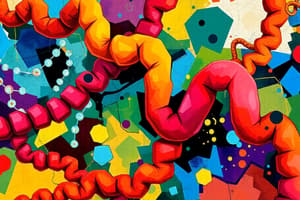Podcast
Questions and Answers
Pyrimidine bases include cytosine, thymine, and ______.
Pyrimidine bases include cytosine, thymine, and ______.
uracil
What nucleic acid stores genetic information?
What nucleic acid stores genetic information?
Deoxyribonucleic acid
Nucleotides are made from a sugar, a base, and a _____ group.
Nucleotides are made from a sugar, a base, and a _____ group.
phosphate
What nucleic acid carries genetic information from DNA to ribosomes?
What nucleic acid carries genetic information from DNA to ribosomes?
What is the monomer of a nucleic acid?
What is the monomer of a nucleic acid?
What are the bonds between amino acids called?
What are the bonds between amino acids called?
What are specialized proteins that act like catalysts?
What are specialized proteins that act like catalysts?
A monomer of a protein is called a _____
A monomer of a protein is called a _____
What is produced when two amino acids form a dipeptide?
What is produced when two amino acids form a dipeptide?
Adenine and Guanine are _____ bases.
Adenine and Guanine are _____ bases.
COOH is known as _____ acid.
COOH is known as _____ acid.
Enzymes are a type of _______.
Enzymes are a type of _______.
A _____ is found in proteins but not in lipids.
A _____ is found in proteins but not in lipids.
_____ fats contain double bonds and a minimum number of hydrogens in their molecular formula.
_____ fats contain double bonds and a minimum number of hydrogens in their molecular formula.
What is the monosaccharide also known as 'blood sugar'?
What is the monosaccharide also known as 'blood sugar'?
What term describes large compounds produced by joining together smaller compounds?
What term describes large compounds produced by joining together smaller compounds?
What process splits polysaccharides back into monosaccharides?
What process splits polysaccharides back into monosaccharides?
This group of organic compounds includes fats, oils, and waxes.
This group of organic compounds includes fats, oils, and waxes.
This group of simple sugars are the monomers that make up more complex carbohydrates.
This group of simple sugars are the monomers that make up more complex carbohydrates.
What term is used to describe a 'double-sugar'?
What term is used to describe a 'double-sugar'?
This is the polysaccharide used by animals to store excess sugar in their bodies.
This is the polysaccharide used by animals to store excess sugar in their bodies.
What is the monomer of a lipid?
What is the monomer of a lipid?
_____ compounds are simply chemical compounds that contain carbon in their molecular formulas.
_____ compounds are simply chemical compounds that contain carbon in their molecular formulas.
What is a general term used to describe the 'building blocks' of a polymer?
What is a general term used to describe the 'building blocks' of a polymer?
_____ synthesis is the polymerization process in which a water molecule is lost.
_____ synthesis is the polymerization process in which a water molecule is lost.
What is the polysaccharide used by plants to store excess sugar in their tissues?
What is the polysaccharide used by plants to store excess sugar in their tissues?
These organic molecules contain carbon, hydrogen, and oxygen in a ratio of 1:2:1.
These organic molecules contain carbon, hydrogen, and oxygen in a ratio of 1:2:1.
Study Notes
Nucleic Acids
- Pyrimidine bases: Include cytosine, thymine, and uracil.
- Deoxyribonucleic acid (DNA): Stores genetic information.
- Nucleotide composition: Comprised of a sugar, a base, and a phosphate group.
- RNA (Ribonucleic acid): Carries genetic information from DNA to ribosomes, essential for protein synthesis.
Protein Structure
- Nucleotide: The monomer unit of nucleic acids.
- Peptide bonds: Form between amino acids, linking them to create proteins.
- Enzymes: Specialized proteins functioning as catalysts to accelerate biochemical reactions.
- Amino acid: The monomer building block of proteins.
Biological Reactions
- Dipeptide formation: The reaction between two amino acids results in the production of water.
- Purine bases: Include adenine and guanine, key components of nucleic acids.
- Carboxyl group (COOH): Also known as carboxylic acid, significant in the structure of amino acids.
Organic Compounds
- Proteins: Enzymes are classified under proteins, highlighting their functional roles in biological processes.
- Nitrogen: A unique element present in proteins but absent in lipids.
- Unsaturated fats: Contain double bonds, resulting in a lower hydrogen count in their molecular structure.
Carbohydrates
- Glucose: Recognized as "blood sugar," a key monosaccharide for energy.
- Polymerization: The process of creating large compounds from smaller units.
- Hydrolysis: A reaction that breaks down polysaccharides into monosaccharides using water.
- Lipid classification: Encompasses fats, oils, and waxes.
Sugar Types
- Monosaccharides: The simplest form of sugars, serving as monomer units for complex carbohydrates.
- Disaccharides: Defined as "double sugars" formed from two monosaccharides.
- Glycogen: The polysaccharide utilized by animals for energy storage, particularly in the liver.
- Starch: The analogous polysaccharide in plants, used for storing excess glucose.
Fundamental Terms
- Triglyceride: The monomer unit of lipids, important for energy storage.
- Organic compounds: Defined by the presence of carbon in their molecular formulas.
- Monomer: The basic building block for polymers, essential in biochemistry.
- Dehydration synthesis: A polymerization process where the formation of larger molecules results in the loss of water.
Studying That Suits You
Use AI to generate personalized quizzes and flashcards to suit your learning preferences.
Description
This quiz explores the fundamental concepts of nucleic acids and protein structure, including the roles of DNA, RNA, amino acids, and enzymes. Participants will test their knowledge on the composition, functions, and reactions involved in biological processes. Get ready to dive into the essential building blocks of life!




